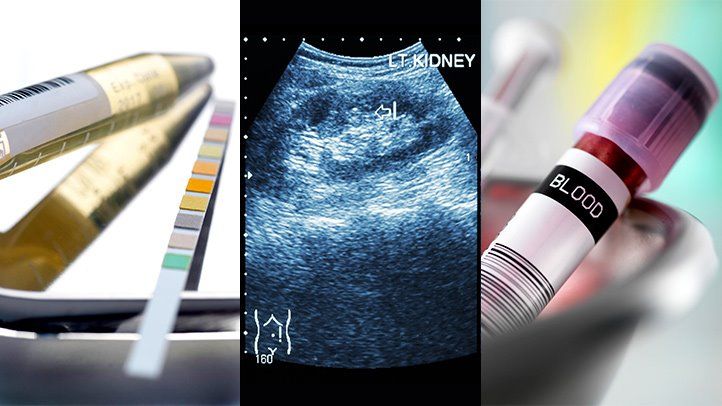Diagnosing kidney stones involves a combination of medical history assessment, physical examination, and various diagnostic tests.
Here’s an overview of the process:
- Medical History and Physical Examination: The first step in diagnosing kidney stones is usually a discussion about the patient’s medical history, including symptoms they’re experiencing. Common symptoms of kidney stones include severe pain in the back, side, lower abdomen, or groin, along with nausea, vomiting, blood in the urine, and frequent urination. A physical examination may also be conducted to check for signs of pain or tenderness in the abdomen or back.
- Imaging Tests: Imaging tests are typically ordered to confirm the presence of kidney stones and to determine their size and location.These tests may include:
- Ultrasound: This non-invasive imaging technique uses sound waves to create images of the kidneys and urinary tract. It can detect the presence of kidney stones and help determine their size and location. However, it may not always detect smaller stones or stones located in certain areas of the urinary tract.
- CT Scan (Computed Tomography): CT scans are highly accurate in detecting kidney stones, even small ones. They provide detailed images of the urinary tract from different angles, allowing healthcare providers to visualize the size, location, and composition of the stones. CT scans are often considered the gold standard for diagnosing kidney stones because of their precision.
- X-ray: X-rays can also be used to detect kidney stones, especially those made of calcium or other minerals that are visible on X-ray images. However, they may not always detect certain types of stones, such as uric acid stones, which are less radiopaque.
- Urinalysis: A urine sample may be collected and analyzed to check for the presence of blood, crystals, or other substances that may indicate the presence of kidney stones. Urinalysis can also help rule out other conditions that may cause similar symptoms.
- Blood Tests: Blood tests may be conducted to assess kidney function and to check for elevated levels of certain substances, such as calcium, uric acid, or creatinine, which can indicate the presence of kidney stones or other related conditions.
- 24-Hour Urine Collection: In some cases, healthcare providers may request a 24-hour urine collection to measure the levels of various substances in the urine, such as calcium, oxalate, citrate, and uric acid. This can help identify the underlying causes of kidney stone formation and guide treatment decisions.
- Medical History and Physical Examination: The first step in diagnosing kidney stones is usually a discussion about the patient’s medical history, including symptoms they’re experiencing. Common symptoms of kidney stones include severe pain in the back, side, lower abdomen, or groin, along with nausea, vomiting, blood in the urine, and frequent urination. A physical examination may also be conducted to check for signs of pain or tenderness in the abdomen or back.
- Imaging Tests: Imaging tests are typically ordered to confirm the presence of kidney stones and to determine their size and location.These tests may include:
- Ultrasound: This non-invasive imaging technique uses sound waves to create images of the kidneys and urinary tract. It can detect the presence of kidney stones and help determine their size and location. However, it may not always detect smaller stones or stones located in certain areas of the urinary tract.
- CT Scan (Computed Tomography): CT scans are highly accurate in detecting kidney stones, even small ones. They provide detailed images of the urinary tract from different angles, allowing healthcare providers to visualize the size, location, and composition of the stones. CT scans are often considered the gold standard for diagnosing kidney stones because of their precision.
- X-ray: X-rays can also be used to detect kidney stones, especially those made of calcium or other minerals that are visible on X-ray images. However, they may not always detect certain types of stones, such as uric acid stones, which are less radiopaque.
- Urinalysis: A urine sample may be collected and analyzed to check for the presence of blood, crystals, or other substances that may indicate the presence of kidney stones. Urinalysis can also help rule out other conditions that may cause similar symptoms.
- Blood Tests: Blood tests may be conducted to assess kidney function and to check for elevated levels of certain substances, such as calcium, uric acid, or creatinine, which can indicate the presence of kidney stones or other related conditions.
- 24-Hour Urine Collection: In some cases, healthcare providers may request a 24-hour urine collection to measure the levels of various substances in the urine, such as calcium, oxalate, citrate, and uric acid. This can help identify the underlying causes of kidney stone formation and guide treatment decisions.
Once kidney stones are diagnosed, the appropriate treatment plan can be developed based on the size, location, and composition of the stones, as well as the patient’s overall health and medical history. Treatment options may include pain management, medications to help pass the stones, or procedures such as lithotripsy or surgery to remove the stones. Additionally, lifestyle changes and dietary modifications may be recommended to prevent future kidney stone formation.





Comments